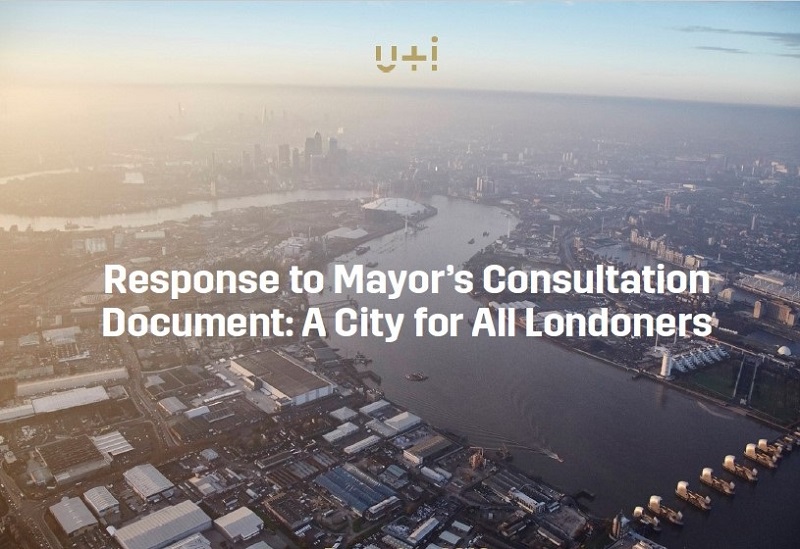Response to Mayors consultation document
Contents |
[edit] Introduction
In December 2016, U+I welcomed the consultation on A City for All Londoners and the Mayor’s willingness to shake things up and to refine London’s planning system as a means of delivering the homes, jobs and places that the city needs.
U+I is active across London and at the forefront of delivering high quality new environments and creative responses that meet both existing and emerging needs. They regularly deliver public private partnership projects, with London Boroughs, Transport for London (TfL) and even the London Fire Brigade.
U+I have pulled together their feedback on the Mayor’s plans.
Part of the response includes a review of planning policy and they have also put forward six key recommendations which they believe would address some of the key issues affecting the Mayor’s direction of travel.
[edit] 1. Enable mixed-use
Local authorities should be directed to encourage productivity on strategic industrial locations (SIL)-designated assets of employment with mixed use developments where exemplary solutions like The Old Vinyl Factory in Hayes can deliver more of the outcomes needed by London.
[edit] 2. Value heritage
Heritage is essential to creating a sense of place. The London Plan should recognise this and provide greater weight to the adoption of historical reference and heritage assets. Greater emphasis should be placed on the value of our heritage assets and local historical context by inspiring future generations to enjoy the richness of the capital as a City of Villages, each with its fine grain.
[edit] 3. Encourage public private collaboration
The Mayor should encourage greater innovative collaboration between public and private sectors to create extraordinary examples of best practice in place making and regeneration.
[edit] 4. Rethink PTAL
Public Transport Access Level (PTAL) is a crude instrument determining the density and development potential and a review of this approach is necessary. U+I suggests that a bias towards high density, mid-rise is far more appropriate than tall buildings.
[edit] 5. Review brownfield potential in the Green Belt
The London Plan should instigate a full review of the potential across London for development of brownfield sites within green belt and metropolitan open land (MOL) as an urgent response to the housing crisis. U+I would be willing to challenge the blanket assumption that all designated green belt is sacrosanct.
[edit] 6. One size does not fit all
Where apartments are for rental in perpetuity, to be designed to exacting standards, the London Plan should encourage the development of smaller homes in a central location.
U+I look forward to continuing a good relationship with the Greater London Assembly (GLA) and to engaging on the preparation and adoption of relevant planning policies to make easier the delivery which London needs and to which they are committed.
The imminent review offers the opportunity for the London Mayor to restructure and update planning policies in a changing and more challenging environment and U+I urge him to do so effectively.
This article was originally published by U+I on 12 Dec 2016.
--U and I
[edit] Related articles on Designing Buildings Wiki
Featured articles and news
Construction Products Reform Green Paper and Consultation
Still time to respond as consultation closes on 21 May 2025.
Resilient façade systems for smog reduction in Shanghai
A technical approach using computer simulation and analysis of solar radiation, wind patterns, and ventilation.
Digital technology, transformation and cybersecurity
Supporting SMEs through Digitalisation in Construction.
Villa Wolf in Gubin, history and reconstruction. Book review.
Construction contract awards down £1bn
Decline over the past two months compared to the same period last year, follows the positive start to the year.
Editor's broadbrush view on forms of electrical heating in context.
The pace of heating change; BSRIA market intelligence
Electric Dreams, Boiler Realities.
New President of ECA announced
Ruth Devine MBE becomes the 112th President of the Electrical Contractors Association.
New CIAT Professional Standards Competency Framework
Supercedes the 2019 Professional Standards Framework from 1 May 2025.
Difficult Sites: Architecture Against the Odds
Free exhibition at the RIBA Architecture Gallery until 31 May.
PPN 021: Payment Spot Checks in Public Sub-Contracts
Published following consultation and influence from ECA.
Designing Buildings reaches 20,000 articles
We take a look back at some of the stranger contributions.
Lessons learned from other industries.
The Buildings of the Malting Industry. Book review.
Conserving places with climate resilience in mind.
Combating burnout.
























